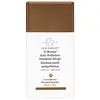What's inside
What's inside
 Key Ingredients
Key Ingredients

 Benefits
Benefits

 Concerns
Concerns

 Ingredients Side-by-side
Ingredients Side-by-side

Water
Skin ConditioningCyclopentasiloxane
EmollientCyclohexasiloxane
EmollientMica
Cosmetic ColorantPropylene Glycol
HumectantCetyl PEG/PPG-10/1 Dimethicone
EmulsifyingDisteardimonium Hectorite
StabilisingPolyglyceryl-3 Diisostearate
EmulsifyingSilica Dimethicone Silylate
AbsorbentSodium Chloride
MaskingPhenoxyethanol
PreservativeHdi/Trimethylol Hexyllactone Crosspolymer
Sodium Dehydroacetate
PreservativeXanthan Gum
EmulsifyingTetrasodium EDTA
Ethylhexylglycerin
Skin ConditioningHelianthus Annuus Seed Oil
EmollientPropylene Carbonate
SolventTocopherol
AntioxidantBeta-Sitosterol
Emulsion StabilisingSilica
AbrasiveSqualane
EmollientTin Oxide
AbrasiveCI 77891
Cosmetic ColorantCI 77491
Cosmetic ColorantCI 77499
Cosmetic ColorantWater, Cyclopentasiloxane, Cyclohexasiloxane, Mica, Propylene Glycol, Cetyl PEG/PPG-10/1 Dimethicone, Disteardimonium Hectorite, Polyglyceryl-3 Diisostearate, Silica Dimethicone Silylate, Sodium Chloride, Phenoxyethanol, Hdi/Trimethylol Hexyllactone Crosspolymer, Sodium Dehydroacetate, Xanthan Gum, Tetrasodium EDTA, Ethylhexylglycerin, Helianthus Annuus Seed Oil, Propylene Carbonate, Tocopherol, Beta-Sitosterol, Silica, Squalane, Tin Oxide, CI 77891, CI 77491, CI 77499
Water
Skin ConditioningHydrogenated Polyisobutene
EmollientGlyceryl Oleate Citrate
EmulsifyingMica
Cosmetic ColorantHydroxyethyl Acrylate/Sodium Acryloyldimethyl Taurate Copolymer
Emulsion StabilisingGlycerin
HumectantRibes Nigrum Seed Oil
EmollientSclerocarya Birrea Seed Oil
HumectantTheobroma Cacao Extract
Skin ConditioningCaprylic/Capric Triglyceride
MaskingVitis Vinifera Seed Extract
AntimicrobialLecithin
EmollientAcetyl Tetrapeptide-17
Skin ConditioningLinoleic Acid
CleansingLinolenic Acid
CleansingSorbitan Isostearate
EmulsifyingCamellia Sinensis Leaf Extract
AntimicrobialMaltodextrin
AbsorbentSodium Hyaluronate Crosspolymer
HumectantMagnolia Officinalis Bark Extract
AntimicrobialGlutamylamidoethyl Imidazole
Colloidal Platinum
AntimicrobialTocopherol
AntioxidantPhenoxyethanol
PreservativePentylene Glycol
Skin ConditioningSodium Benzoate
MaskingSorbic Acid
PreservativeCaprylyl Glycol
EmollientBoron Nitride
AbsorbentHexylene Glycol
EmulsifyingPolysorbate 60
EmulsifyingEthylhexylglycerin
Skin ConditioningCI 77491
Cosmetic ColorantCI 77492
Cosmetic ColorantCI 77499
Cosmetic ColorantSodium C14-16 Olefin Sulfonate
CleansingWater, Hydrogenated Polyisobutene, Glyceryl Oleate Citrate, Mica, Hydroxyethyl Acrylate/Sodium Acryloyldimethyl Taurate Copolymer, Glycerin, Ribes Nigrum Seed Oil, Sclerocarya Birrea Seed Oil, Theobroma Cacao Extract, Caprylic/Capric Triglyceride, Vitis Vinifera Seed Extract, Lecithin, Acetyl Tetrapeptide-17, Linoleic Acid, Linolenic Acid, Sorbitan Isostearate, Camellia Sinensis Leaf Extract, Maltodextrin, Sodium Hyaluronate Crosspolymer, Magnolia Officinalis Bark Extract, Glutamylamidoethyl Imidazole, Colloidal Platinum, Tocopherol, Phenoxyethanol, Pentylene Glycol, Sodium Benzoate, Sorbic Acid, Caprylyl Glycol, Boron Nitride, Hexylene Glycol, Polysorbate 60, Ethylhexylglycerin, CI 77491, CI 77492, CI 77499, Sodium C14-16 Olefin Sulfonate
Ingredients Explained
These ingredients are found in both products.
Ingredients higher up in an ingredient list are typically present in a larger amount.
Ci 77491 is also hydrated iron III oxide. It's sole purpose is to give a red/pink hue to products.
Iron III oxides are classified as inorganic chemicals for coloring.
Synthetically created Ci 77491 is considered safer than those naturally found. This is because the synthetically created version may contain less impurities. Iron oxides are generally non-toxic and non-allergenic.
Learn more about CI 77491Ci 77499 is also hydrated iron III oxide. It is created from mixing red and black iron oxides. This helps give shades of darkness to a product.
Iron III oxides are classified as inorganic chemicals for coloring.
Ethylhexylglycerin (we can't pronounce this either) is commonly used as a preservative and skin softener. It is derived from glyceryl.
You might see Ethylhexylglycerin often paired with other preservatives such as phenoxyethanol. Ethylhexylglycerin has been found to increase the effectiveness of these other preservatives.
Mica is a naturally occurring mineral used to add shimmer and color in cosmetics. It can also help improve the texture of a product or give it an opaque, white/silver color.
Serecite is the name for very fine but ragged grains of mica.
This ingredient is often coated with metal oxides like titanium dioxide. Trace amounts of heavy metals may be found in mica, but these metals are not harmful in our personal products.
Mica has been used since prehistoric times throughout the world. Ancient Egyptian, Indian, Greek, Roman, Aztec, and Chinese civilizations have used mica.
Learn more about MicaPhenoxyethanol is a preservative that has germicide, antimicrobial, and aromatic properties. Studies show that phenoxyethanol can prevent microbial growth. By itself, it has a scent that is similar to that of a rose.
It's often used in formulations along with Caprylyl Glycol to preserve the shelf life of products.
Tocopherol (also known as Vitamin E) is a common antioxidant used to help protect the skin from free-radicals and strengthen the skin barrier. It's also fat soluble - this means our skin is great at absorbing it.
Vitamin E also helps keep your natural skin lipids healthy. Your lipid skin barrier naturally consists of lipids, ceramides, and fatty acids. Vitamin E offers extra protection for your skin’s lipid barrier, keeping your skin healthy and nourished.
Another benefit is a bit of UV protection. Vitamin E helps reduce the damage caused by UVB rays. (It should not replace your sunscreen). Combining it with Vitamin C can decrease sunburned cells and hyperpigmentation after UV exposure.
You might have noticed Vitamin E + C often paired together. This is because it is great at stabilizing Vitamin C. Using the two together helps increase the effectiveness of both ingredients.
There are often claims that Vitamin E can reduce/prevent scarring, but these claims haven't been confirmed by scientific research.
Learn more about TocopherolWater. It's the most common cosmetic ingredient of all. You'll usually see it at the top of ingredient lists, meaning that it makes up the largest part of the product.
So why is it so popular? Water most often acts as a solvent - this means that it helps dissolve other ingredients into the formulation.
You'll also recognize water as that liquid we all need to stay alive. If you see this, drink a glass of water. Stay hydrated!
Learn more about Water